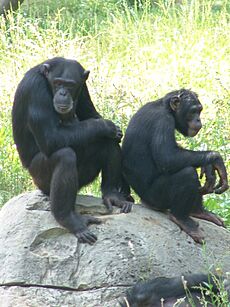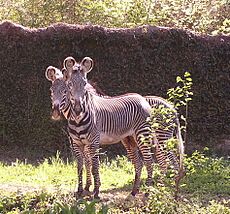Jackson Zoo facts for kids
 |
|
| Date opened | 1919 |
|---|---|
| Location | Jackson, Mississippi, United States |
| Coordinates | 32°19′13″N 90°13′15″W / 32.3202°N 90.2207°W |
| No. of animals | 250 |
| No. of species | 120 |
| Annual visitors | 120,000 |
| Memberships | Zoological Association of America |
| Major exhibits | African Rainforest, African Savannah, Asian Garden, Wilderness Mississippi |
The Jackson Zoo is a fun place in Jackson, Mississippi, where you can see animals from all over the world! It first opened in 1919 and is home to about 250 animals, representing more than 120 different kinds of species. The zoo is located in the beautiful Livingston Park, which is about 110 acres (45 hectares) big.
Every year, thousands of people visit the Jackson Zoo, including many school children who come to learn about wildlife. It's the second largest zoo in Mississippi and was once the only one in the state to be recognized by the Zoological Association of America (ZAA) for its animal care.
Discovering the Jackson Zoo's Past
How the Zoo Began
The story of the Jackson Zoo started in 1916 when the city bought a large piece of land. By 1919, a group of firefighters had started collecting animals like rabbits and squirrels. They kept these animals at the central fire station.
In 1921, their collection grew to include more exotic animals, such as zebras. The city decided to move these animals to the newly purchased land, and that's how the Livingston Park Zoo was created!
Building the Zoo During Tough Times
During the 1930s, a time known as the Great Depression, many new buildings were constructed at the zoo. This was thanks to a program called the Works Progress Administration (WPA). This program helped create jobs for people and left behind many buildings that are still standing today. For example, a building called "The Castle" used to be home to many rhesus macaque monkeys. The Elephant House Café once housed a young Asian elephant. The zoo grounds also served as a lovely park with a lake for visitors to enjoy.
New Animals and Important Changes
In 1948, the zoo's animal collection grew even more. With help from Jacob L. Reddix, who was the President of Jackson State College, the zoo was able to get several rainforest animals from Liberia. These included chimpanzees, rare mangabey monkeys, a colobus monkey, a lemur, and two large pythons.
In the 1960s, an important change happened. The zoo, like other public places in Jackson, used to be separated by race. However, a court decision in 1962 made it clear that all public facilities, including the Jackson Zoo, had to be open to everyone, no matter their race. This was a big step towards fairness and equality.
Growing and Improving the Zoo
The 1970s brought new additions, like a children's petting zoo, which later became the Discovery Zoo. An animal hospital was also built to help care for the animals, giving them regular checkups and any needed surgeries. It also helped new animals settle in safely.
In 1985, the zoo expanded its space and created the African Rainforest Exhibit. By 1989, the zoo earned special recognition from the Association of Zoos and Aquariums (AZA), showing its commitment to high standards of animal care.
The state government provided $4 million in 1995 for improvements, and the city added $1.5 million in 1998. This led to big projects, including the African savannah and Mississippi Wilderness Exhibits, which were the largest improvements in the zoo's history.
In 2004, the Friends of the Zoo added a fun new Endangered Species Carousel. Instead of traditional horses, you could ride zebras, leopards, giraffes, and tigers!
Recent Years at the Zoo
The African Savannah Exhibit opened in 2005, giving visitors a chance to feel like they were on an expedition. In 2006, the Wilderness Mississippi area opened, showcasing animals native to the state. The zoo also welcomed two orangutans from Borneo.
In 2007, the Jackson Zoo was recognized as the "Travel Attraction of the Year" by the Mississippi Tourism Association. This showed how much the zoo had grown and improved.
In 2010, the zoo's two popular elephants moved to another zoo to join a larger herd. This was because the Jackson Zoo didn't have enough space for their needs. The Southern white rhinoceros then became the largest mammal at the zoo, moving into the former elephant home.
In 2017, the orangutans also moved to new homes because their enclosure needed updates, and funding was not available at the time.
In September 2019, the zoo temporarily closed to the public to update its licensing. Zoo staff continued to care for all the animals. By August 2020, the zoo reopened with limited hours, and a new management agreement was being finalized to help the zoo continue its important work.
Amazing Animals and Exhibits
The Jackson Zoo is home to about 250 animals from over 120 different species. The zoo is always working to improve its exhibits to meet modern standards for animal care. Some of the zoo's historic buildings, like the Elephant House Cafe and the Monkey Castle, are recognized as historic landmarks. While these buildings are no longer home to living animals, they are an important part of the zoo's history.
The zoo has several special areas that show animals from different parts of the world: the African Rainforest, African Savannah, Asian Garden, and Wilderness Mississippi.
African Rainforest
Step onto a boardwalk in the African Rainforest exhibit and feel like you're deep in a jungle!
- Pygmy Hippopotamus Pool: Here, you'll find three pygmy hippos swimming in a large lake. These hippos are smaller than their cousins, the Nile hippopotamus. They love to swim or roll around in mud holes.
- Chimpanzee Island: The zoo has four chimpanzees living on a big island in this exhibit.
- Old World Monkey Exhibit: This area shows how different animals can live together. You might see two kinds of monkeys here: Schmidt's guenons and eastern black-and-white colobus.
- Other animals in the African Rainforest include Diana monkeys and red river hogs, each playing a special role in their rainforest ecosystem.
African Savannah
The African Savannah exhibit makes you feel like you're on an adventure in the open plains of Africa! It opened in 2005 and features two large open areas.
This exhibit is home to many different animals, including antelopes, birds, and even reptiles. You can see southern white rhinos, sable antelopes, Grévy's zebras, klipspringers, wattled cranes, and ostriches roaming in this spacious area.
Asian Garden
Near the zoo's entrance, the Asian Garden features grottos where you can see powerful Sumatran tigers and Asian black bears. Next to them, you'll find the tall reticulated giraffes, even though they are from Africa, not Asia. Smaller enclosures in this garden are home to fishing cats and lar gibbons.
Wilderness Mississippi
In 2006, the Jackson Zoo opened a special section just for Mississippi's amazing native animals. This area shows off many of the state's natural ecosystems. You can see American alligators, North American river otters, American beavers, cougars, and even rattlesnakes here.
The first building in this area is called Backyard Creatures, which is home to venomous snakes.
Other Animals to See
Beyond these main exhibits, the zoo also has many other interesting animals. These include black-headed spider monkeys, black-tailed prairie dogs, cotton-top tamarins, red ruffed lemurs, red wolves, American flamingos, laughing kookaburras, and black-necked swans, along with several other birds and reptiles.
Images for kids













